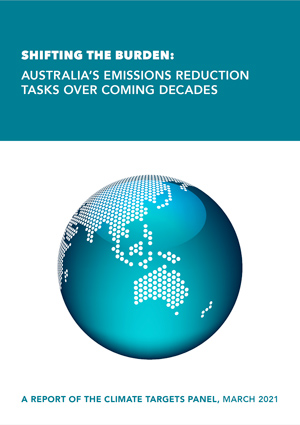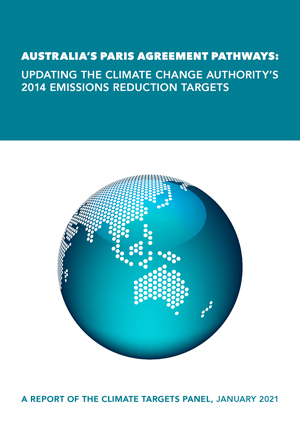Australia's Paris Agreement Pathways
SHIFTING THE BURDEN:
Australia's emissions reduction tasks over coming decades
Climate Targets Panel, March 2021
ABOUT THIS REPORT
This is the second report of the Climate Targets Panel. Earlier this year, we published our findings about Australia’s required emissions reduction targets if we are to do our fair share in limiting global warming to well below 2° and 1.5° Celsius respectively, both of which are goals referred to in the Paris Agreement. We found that for Australia to remain within its remaining ‘2°’ carbon budget, we would need to reduce emissions by 50% on 2005 levels by 2030, reaching net zero emissions by 2045. To remain within the remaining '1.5°’ carbon budget, the targets would be 74% below 2005 levels by 2030 and net zero emissions by 2035. Since the release of our report, there has been public discussion of Australia retaining its existing 2030 emissions reductions targets of 26-28%, but then proceeding to net-zero by 2050. We understand some of the Prime Minister’s recent comments to have aired such a possibility, with references to net-zero ‘as soon as possible, and preferably by 2050’. This second report considers what such an approach would mean for Australia’s emissions reductions efforts over the next three decades to 2050.
The Authors
John Hewson AM, Professor Will Steffen, Professor Lesley Hughes and A/Prof Malte Meinshausen
AUSTRALIA’S PARIS AGREEMENT PATHWAYS
UPDATING THE CLIMATE CHANGE AUTHORITY’S 2014 EMISSIONS REDUCTION TARGETS
Climate Targets Panel, January 2021
ABOUT THIS REPORT
The Secretary General of the United Nations has made it clear that the world’s current greenhouse reduction pledges are not enough to limit global warming to well below 2°C, the goal of the Paris Agreement, and has beseeched the parties to the Paris Agreement to more rapidly cut pollution. United States President Joe Biden has signalled that he will hold a global summit in the first 100 days of his presidency, at which he will ask countries to do more. Later in 2021, countries of the world will meet at the next global climate summit, the Conference of the Parties, where they will be asked to lift their emissions-reduction ambitions. To do its fair share and to be compliant with the goals of the Paris Agreement, Australia must increase its emissions reduction targets. Australia’s own Climate Change Authority (CCA) produced a key review in 2014, which set out the targets Australia needed to follow to help limit global warming to less than 2°C. Since then, the CCA has not updated this research. The authors of the current paper, the Climate Targets Panel, have prepared this report to ensure that debate about the targets Australia takes to these upcoming summits to meet the Paris Agreement 2°C goal are informed by sound science and policy. The Climate Targets Panel is an independent group of Australia’s most senior climate scientists and policymakers who have come together for the purpose of ensuring that debate about Australia’s emissions reductions targets are informed by sound science and policy. Concerned that the federal CCA has not published any comprehensive analysis of Australia’s climate targets since 2014, but given that Australia’s climate targets will be a focus in 2021, this ad hoc group has come together to update the CCA’s 2014 analysis to help inform the Australian debate.
The Authors
John Hewson AM, Professor Will Steffen, Professor Lesley Hughes and A/Prof Malte Meinshausen
| Attachment | Size |
|---|---|
| 826.02 KB | |
| 736.71 KB |

